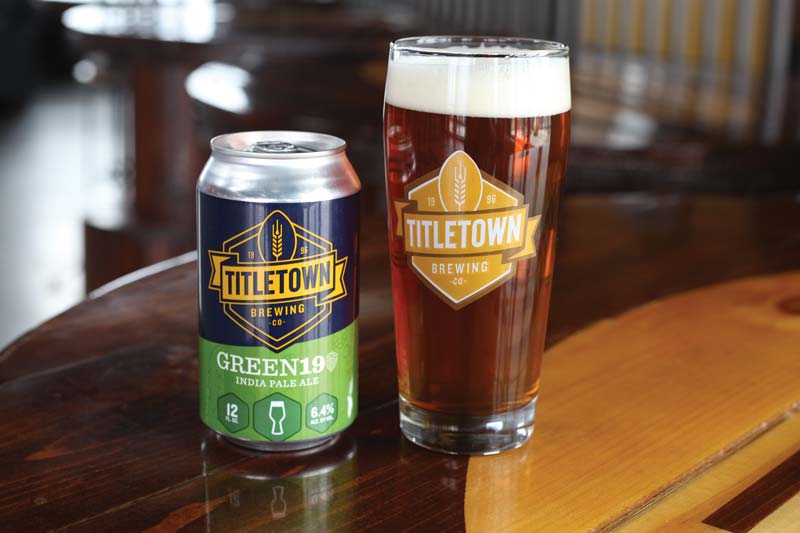Titletown Brewing Company
Dear Replicator,
My wife and I used to live outside of Chicago, Illinois and made it a habit to venture to Green Bay, Wisconsin at least once a year. Titletown Brewing Co’s Green 19 IPA is very much to our liking and it also makes a pretty good black IPA when half-and-half’ed with Titletown’s Dark Helmet Schwarzbier. We now live in the Denver, Colorado metro area and can’t as easily travel to Green Bay, but as the homebrewer in the house, I would love to replicate Green 19 at home.
Markus P. Hagmann
Aurora, Colorado
Green Bay’s Titletown Brewing Co. celebrates the city’s rich history of blue-collar folks who loved hard work, community, and, of course, a great beer or two at the end of the work day. The brewery itself can be considered a living, breathing time capsule that easily transports today’s craft beer drinkers to a time and place where their grandparents and great-grandparents gathered and celebrated life’s biggest moments, likely over beers.
Yesterday and Today
The first trip through time took place when Titletown Brewing Co. purchased and renovated a building at an old train depot originally constructed in 1899, the historic Chicago & Northwestern Railway passenger depot. The spot could be considered the social gathering place of the area from the time of its construction until the depot was permanently shut down in 1994.

In December 1996, Titletown opened its doors and this bustling brewpub quickly became a community favorite. As popularity grew, it didn’t take long to max out its 15-barrel system, even without any outside distribution. In 2014, the company expanded by purchasing and renovating another historic facility, the former Larsen Canning building adjacent to the original location. The new location enabled the brewery to purchase larger brewing vessels (now a 30-barrel system), which allowed for distribution within the state of Wisconsin for the first time. 2014 also saw the addition of Jed Petrie, Titletown’s current Brewmaster, originally brought on as the “lab guy” in charge of quality control.
Along with the full-production brewing system, Titletown added a taproom on the ground floor, as well as an indoor/outdoor “roof-tap” biergarten on the top of the building. The pandemic struck just as the new facility was taking shape, straining the brewery’s resources greatly. Titletown persevered, and once the pandemic eased, fans of the brewery came back in droves, once again making this communal area in downtown Green Bay a hot spot.
Bottling vs. Canning
The company bottled its beers for the first six years before adding cans to the mix. Today, 100% of their distribution is in cans, which is better for both the beer and the company’s financials.
“Canning is so much better for the beer,” said Petrie. “Cans hold up longer than bottles due to less oxygen and light intake. Cans are easier to store and ship, and it helps with date codes. Cans are, hands down, superior to bottling when it comes to distributing quality beer.”
Titletown Beers
A brewery doesn’t achieve huge popularity without a lineup of solid beers. Year-round beers include Dark Helmet Schwarzbier (a dark lager), Boat House Pilsner (a Czech-style Pilsner), 400 Honey Ale (a golden ale with local Wisconsin honey), Johnny Blood Red (an Irish-style red ale, and a personal favorite of Petrie), as well as Green 19 IPA (an India pale ale that, according to Petrie, was ahead of its time).
Green 19 IPA
“We wanted to emphasize the fruity, citrusy side of the IPA spectrum without being over the top with bittering,” said Petrie. “For many years, Green 19 IPA was made with just enough bitterness to balance the malts and not overpower, something you see out of many IPAs today. When it came to competitions, however, the low-level bitterness put Green 19 a little out of style because it wasn’t oppressively bitter. The beer is balanced and you can taste the piney and grapefruit character that comes from the Citra® and Cascade hops.”
Created around 2005, Green 19 was originally named Hopasaurus Rex. The beer’s recipe has morphed somewhat over the years, but was always a modern IPA before its time. Green 19 has traditionally employed either a small 60-minute hop addition, or at times, none at all. Trading bitterness for hop flavor, balance is the goal, especially with generous additions of caramel and Victory® malt that provide additional body, color, and balancing sweetness.
“The specialty malts help provide a bit of a nutty character to the beer; a perfect counterpoint to the citrus and piney hop flavor,” said Petrie.
Today, Green 19 checks in at 6.5% ABV with 55 IBU, still on the low end for an IPA. “It’s all about adding the right hops at the right time,” said Petrie.
While IPAs usually hit the spot paired with fried foods, Petrie’s dish of choice is a juicy ribeye.
“I find that enjoying a delicious steak and washing it down with a Green 19 IPA really brings out the best flavors in both the steak and the beer,” said Petrie.
Before you fire up the grill or get out your deep fryer, be sure to brew up your own batch of this Green 19 IPA clone and let the hop flavors bring out the best with your favorite food pairing.
Titletown Brewing Company’s Green 19 IPA clone

(5 gallons/19 L, all-grain)
OG = 1.060 FG = 1.014
IBU = 50+ SRM = 8 ABV = 6.2%
Ingredients
11 lbs. (5 kg) pale ale malt
10 oz. (284 g) Munich malt (10 °L)
7 oz. (198 g) biscuit malt (35 °L)
4 oz. (113 g) CaraMunich® Type 3 malt (60 °L)
7.8 AAU Horizon hops (60 min.) (0.6 oz./17 g at 13% alpha acids)
7.8 AAU Chinook hops (15 min.) (0.6 oz./17 g at 13% alpha acids)
1.1 AAU Citra® hops (15 min.) (0.1 oz./3 g at 11% alpha acids)
1.1 AAU Cascade hops (8 min.) (0.2 oz./6 g at 5.4% alpha acids)
5.9 AAU Chinook hops at (8 min.) (0.45 oz./13 g at 13% alpha acids)
1.7 AAU Citra® hops (8 min.) (0.15 oz./4 g at 11% alpha acids)
0.66 AAU Horizon hops (8 min.) (0.05 oz./1.4 g at 13% alpha acids)
2.4 AAU Cascade hops (1 min.) (0.45 oz./13 g at 5.4% alpha acids)
5.9 AAU Chinook hops (1 min.) (0.45 oz./13 g at 13% alpha acids)
2.2 AAU Citra® hops (1 min.) (0.2 oz./6 g at 11% alpha acids)
0.66 AAU Horizon hops (1 min.) (0.05 oz./1.4 g at 13% alpha acids)
8.6 AAU Cascade hops (0 min.) (1.6 oz./45 g at 5.4% alpha acids)
5.2 AAU Chinook hops (0 min.) (0.4 oz./11 g at 13% alpha acids)
2.8 AAU Citra® hops (0 min.) (0.25 oz./7 g at 11% alpha acids)
3.3 AAU Horizon hops (0 min.) (0.25 oz./7 g at 13% alpha acids)
0.9 oz. (26 g) Cascade hops (dry hops)
0.2 oz. (6 g) Chinook hops (dry hops)
0.65 oz. (18 g) Citra® hops (dry hops)
0.45 oz. (13 g) Horizon hops (dry hops)
SafAle US-05, Wyeast 1056 (American Ale), or White Labs WLP001 (California Ale) yeast
¾ cup corn sugar (if priming)
Step by Step
Mash in with 15.4 qts. (14.5 L) of water to achieve a mash temperature of 150 °F (66 °C). Add phosphoric acid to adjust pH to 5.2–5.3. Hold for at least 30 minutes or until fully converted. Raise temperature to 168 °F (76 °C) for mash out. Vorlauf until runnings are clear. Collect wort; sparge until reaching 6 gallons (23 L) in the kettle.
Boil for 60 minutes with the above hop additions. Add hot water (while wort is still at or near-boiling temperatures) to adjust gravity to 1.060, then whirlpool for 20 minutes. Rapidly cool the wort to 65 °F (18 °C). Thoroughly oxygenate wort if using a liquid yeast strain, then pitch yeast. Ferment at 65–66 °F (18–19 °C). Once primary fermentation has slowed significantly, add dry hops. Four days after dry hopping, crash temperature to 35 °F (2 °C), but only when confident fermentation is complete. Carbonate to 2.6 volumes.
Titletown Brewing Company’s Green 19 IPA clone
(5 gallons/19 L, partial mash)
OG = 1.060 FG = 1.014
IBU = 50+ SRM = 8 ABV = 6.2%
Ingredients
5.88 lbs. (2.67 kg) Briess CBW® Pale Ale dried malt extract
10 oz. (284 g) Munich malt (10 °L)
7 oz. (198 g) biscuit malt (35 °L)
4 oz. (113 g) CaraMunich® Type 3 malt (60 °L)
Follow hop schedule & yeast options from all-grain recipe
Step by Step
Mash in with 2 gallons (7.6 L) of water to achieve a mash temperature of 150 °F (65.6 °C). Place the crushed malts in a muslin bag and mash for at least 45 minutes or until fully starch is fully converted.
Once mashing is complete, remove grain bag and let the liquid drip out without squeezing the grains.
Raise the temperature to near boiling. Remove pot from heat source and add half of the total malt extract slowly, stirring constantly. Bring to a boil. Boil for 60 minutes with the indicated hop additions. Taking the pot temporarily off the heat source, stir in the remaining malt extract very slowly with 5–10 minutes left in the boil, then return to heat source. Meanwhile, pre-boil 3.5 gallons (13.3 L) of water, and chill it as close to 65 °F (18 °C), to later top up your wort.
When boil is complete, whirlpool for 20 minutes. Rapidly cool the wort to 65 °F (18 °C). Top up the wort by adding the pre-boiled water. Thoroughly oxygenate wort if using a liquid strain, then pitch yeast. Ferment at 65–66 °F (18–19 °C). Once primary fermentation has nearly ceased, add dry hops (on or shortly after day 7). Four days after dry hopping, crash temperature to 35 °F (2 °C), but only when confident fermentation is complete. Carbonate to 2.6 volumes.
Tips For Success:
Don’t get stressed out if your brewing program comes up with wildly different IBU calculations. When there are this many hop additions, variance is bound to happen. Following Titletown Brewing Company’s recipe will produce a very aromatic and flavorful hop character in your beer, with only a moderate level of bitterness. Of course, if the alpha acid numbers on your hops are much different than those listed, adjust your quantities accordingly. The key to a successful brew is ensuring your hops are as fresh as possible and from a trusted source.



